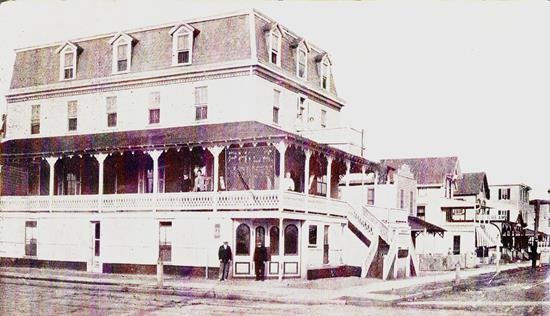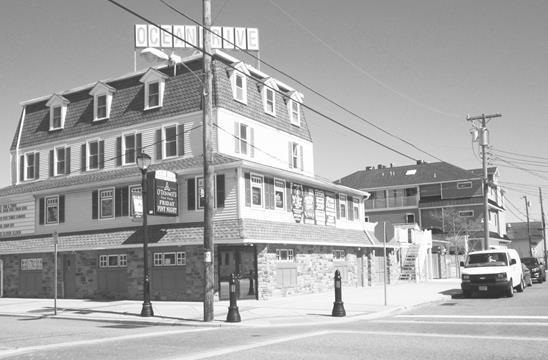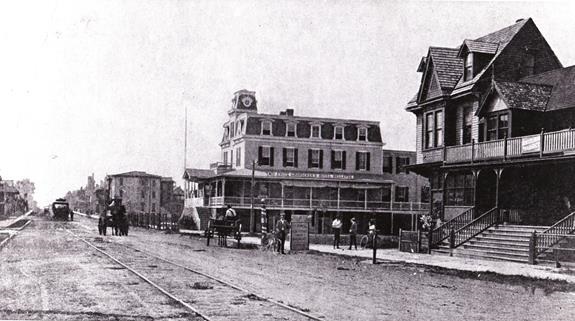
Back in the 1890s, when Sea Isle was bustling through its second decade, the town was dominated by grand hotels, steam-powered railways, all sorts of visitor venues such as Excursion House – and, of course, the beach.
The visitors still come and the beach is still here, but most of the city’s landscape has long since come and gone. The hotels gave way to cottages, then condominiums. The railroad gave way to the motorcar. Excursion House gave way to Excursion Park via the 1962 storm. And so on.
What follows is a selection of then-and-now snapshots of some recognizable Sea Isle City scenes. The “now” photos were taken in a recent off-season, when it seemed relatively safe to stand in the middle of the street. (Hordes of pedestrians and SUVs can be penciled in.)
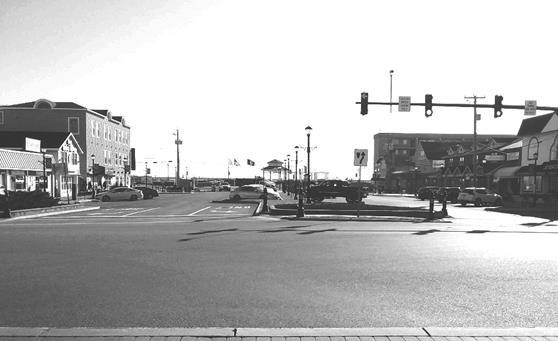
Landis Avenue
Landis Avenue has always been Sea Isle’s Main Street. On the left is an early 1900s view looking south from 39th Street with Cronecker’s Bellevue Hotel in the center. It shows the four main modes of local transportation of the time – two bicycles, two horse-and-buggies, several feet, and even a trolley…
Early 1900s
Move forward a few decades. This is the view from JFK Boulevard looking north. Cronecker’s is still there on the left, but things have gotten decidedly more crowded. It looks like parking was already a problem…
At the corner of Landis Avenue and JFK, turn to the east and face the ocean. Note the railroad tracks, the Women’s Civic Club building in the center, and the imposing Excursion House at the left. They’re all gone now, swept away by storms and progress…
Walk farther south along Landis Avenue to 43th Street, and look to the south. Two churches are in view: one, the familiar St. Joseph’s at the far right; and the other, the Methodist Church in the distance on the left, which moved to 45th and Landis in 1905 to avoid the loud locomotives at its earlier location. Farther along on the right stands the Lincoln Hotel which housed Sea Isle’s first post office.
Some things don’t change much.
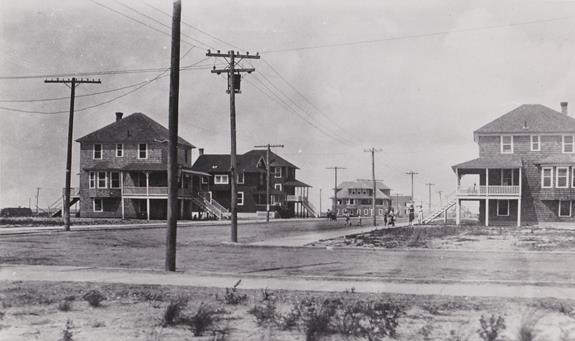
The Boardwalk at JFK Boulevard
The boardwalk was, and still is, Sea Isle’s center of amusement both day and night, although the boards are long gone and now it’s called the Promenade. The first boardwalk was built in 1907 and extended from 20th to 63rd Street. It was washed out by storms at least three times, and finally rebuilt with black asphalt in 1963. It seems pretty sturdy today.
Current scenes along the Promenade bear little resemblance to those of a century ago. Gone are the Ocean Pier, Excursion House, impressive hotels such as the Continental, plus any number of venues geared to feed and amuse the public.
People have always gathered at the beach end of JFK Boulevard in the summer to be entertained on the boardwalk. But it would be hard to beat the crowds that jammed in to witness a concert in the Roaring Twenties.
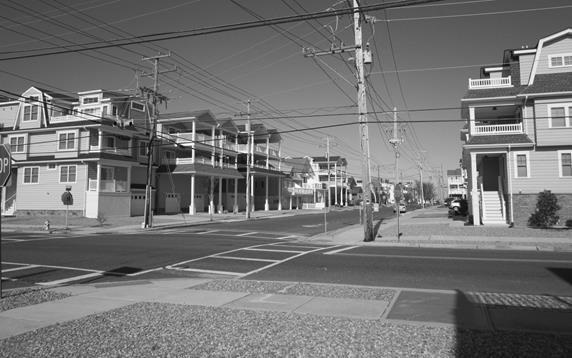
In the photo below, they all seem to be posing for the camera. (The constable on duty in the front row was a man named John Finan, clearly on the lookout for evildoers – and cameramen) The Women’s Civic Club and Excursion House are in the background…
Concert crowd – circa 1920
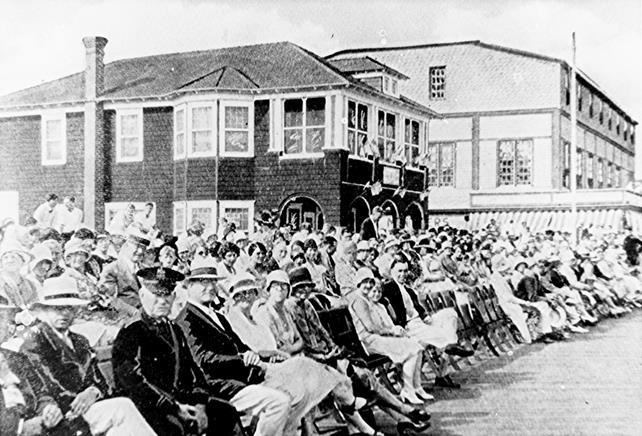
Pleasure Avenue
Pleasure Avenue got its name from the Pleasure Railroad, which existed at a time when trains were the main form of transport between Stone Harbor and Ocean City, and between Sea Isle City and points west.
The trains started running in the 1880s and continued well into the twentieth century, until they were totally replaced by Henry Ford’s motorcar. The tracks were torn up and the track lines became actual streets – and Pleasure Avenue began to resemble what it looks like today.
The following two sets of photographs give an idea of the change. It was welcome progress, unless one was a shareholder of the Pennsylvania Railroad.
This first view is typical of Pleasure Avenue when the train was king. The municipal tennis courts on Ocean Avenue (JFK Boulevard) can be seen in the far center of the picture. The next image is the same scene. Both photos were taken from 39th Street looking south on Pleasure Avenue…
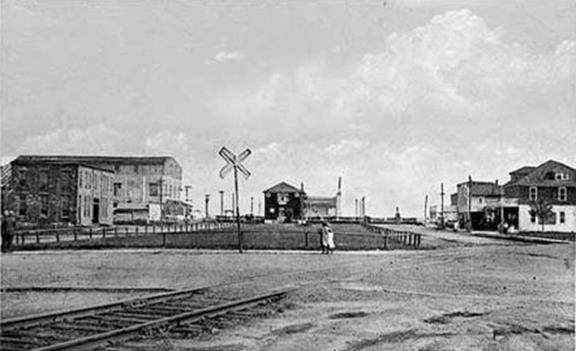
A century ago, this was the view that greeted the Pleasure Railroad engineer as his steam locomotive started to make its sharp turn to the west from Pleasure Avenue onto JFK Boulevard, on its way from Townsend’s Inlet to the Sea Isle City Station. The speed limit for trains chugging through town was ten miles per hour – but probably a lot less at this juncture to avoid demolishing the tennis courts ahead…
Toward the Bay
Just as today, most of the city’s action – and congestion – gravitated to the center of town and to the ocean. To the west toward Ludlam’s Thorofare, the atmosphere has always been a lot calmer, with no hotels or amusement centers.
The scene below is of 44th Street from Central Avenue looking west. It was once the main (and only) auto route into town from the mainland. But even here there wasn’t a lot of bustle by the bay. Charles Landis built his house here; it’s the fourth on the left in the “Then” photo. Today, 44th Street is still a residential area – just a bit more compact.
A few blocks farther north, in the early part of the 20th century, fish houses lined the 42nd Street Canal. Pound fisherman would return here from the ocean with boatloads of freshly caught fish for processing and distribution. Today, the scene is a bit different, although fishing excursions are still on the menu…
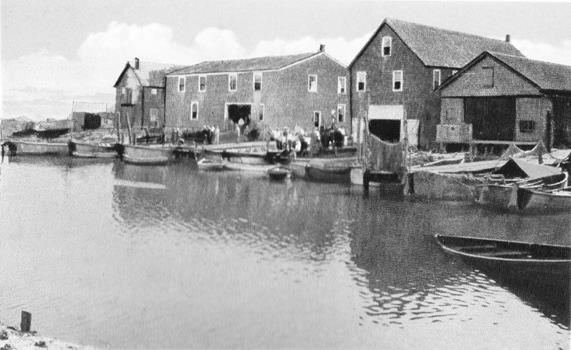
But some things never change
Even with all the tearing-down and building-up inherent in the town’s growth, a few stalwarts have so far managed to survive from the old days. One of the more prominent and recognizable is the Ocean Drive Bar and Restaurant at the corner of 40th Street and Landis Avenue. There are others: the Colonnade Inn, the Cape May County Times building, St. Joseph’s Church, the Townsend’s Inlet life- saving station, the little church in T.I., and more. While Sea Isle doesn’t have a “Historic District” per se, one can still walk around town and spot memories from a century ago.
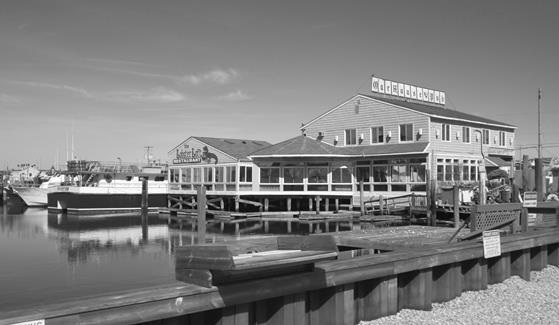
But change is always in the wind. The scenes shown here as “Now” photos will be altered sometime, if not sooner – if not already. It’s guaranteed.
To enjoy our collection of photos, literature, and artifacts, please plan to visit the Sea Isle City Historical Museum at 48th Street and Central Avenue in the future. (The museum is temporarily closed due to COVID-19.) Access the website at www.seaislemuseum.com.
Call 609-263-2992 for more information.
This “Spotlight on History” was written by Sea Isle City Historical Society Volunteer Bob Thibault. The “Then” photos were provided courtesy of the Sea Isle City Historical Museum. The “Now” photos were provided by Bob Thibault.
